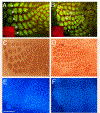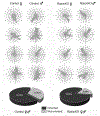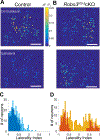Layers 3 and 4 Neurons of the Bilateral Whisker-Barrel Cortex
- PMID: 35598701
- PMCID: PMC9884091
- DOI: 10.1016/j.neuroscience.2022.05.018
Layers 3 and 4 Neurons of the Bilateral Whisker-Barrel Cortex
Abstract
In Robo3R3-5cKO mouse brain, rhombomere 3-derived trigeminal principal nucleus (PrV) neurons project bilaterally to the somatosensory thalamus. As a consequence, whisker-specific neural modules (barreloids and barrels) representing whiskers on both sides of the face develop in the sensory thalamus and the primary somatosensory cortex. We examined the morphological complexity of layer 4 barrel cells, their postsynaptic partners in layer 3, and functional specificity of layer 3 pyramidal cells. Layer 4 spiny stellate cells form much smaller barrels and their dendritic fields are more focalized and less complex compared to controls, while layer 3 pyramidal cells did not show notable differences. Using in vivo 2-photon imaging of a genetically encoded fluorescent [Ca2+] sensor, we visualized neural activity in the normal and Robo3R3-5cKO barrel cortex in response to ipsi- and contralateral single whisker stimulation. Layer 3 neurons in control animals responded only to their contralateral whiskers, while in the mutant cortex layer 3 pyramidal neurons showed both ipsi- and contralateral whisker responses. These results indicate that bilateral whisker map inputs stimulate different but neighboring groups of layer 3 neurons which normally relay contralateral whisker-specific information to other cortical areas.
Keywords: Ca(2+)-fluorescence protein; In vivo 2-photon imaging; conditional Robo3 knockout; dendritic complexity; somatosensory cortex; whiskers.
Copyright © 2022 IBRO. All rights reserved.
Figures






Similar articles
-
Behavioral Consequences of a Bifacial Map in the Mouse Somatosensory Cortex.J Neurosci. 2017 Jul 26;37(30):7209-7218. doi: 10.1523/JNEUROSCI.0598-17.2017. Epub 2017 Jun 29. J Neurosci. 2017. PMID: 28663199 Free PMC article.
-
Dynamic representation of whisker deflection by synaptic potentials in spiny stellate and pyramidal cells in the barrels and septa of layer 4 rat somatosensory cortex.J Physiol. 2002 Aug 15;543(Pt 1):49-70. doi: 10.1113/jphysiol.2002.018465. J Physiol. 2002. PMID: 12181281 Free PMC article.
-
Contribution of supragranular layers to sensory processing and plasticity in adult rat barrel cortex.J Neurophysiol. 1998 Dec;80(6):3261-71. doi: 10.1152/jn.1998.80.6.3261. J Neurophysiol. 1998. PMID: 9862920
-
What can we get from 'barrels': the rodent barrel cortex as a model for studying the establishment of neural circuits.Eur J Neurosci. 2011 Nov;34(10):1663-76. doi: 10.1111/j.1460-9568.2011.07892.x. Eur J Neurosci. 2011. PMID: 22103423 Free PMC article. Review.
-
Mapping functional connectivity in barrel-related columns reveals layer- and cell type-specific microcircuits.Brain Struct Funct. 2007 Sep;212(2):107-19. doi: 10.1007/s00429-007-0147-z. Epub 2007 Jun 26. Brain Struct Funct. 2007. PMID: 17717691 Review.
Cited by
-
Bilateral Whisker Representations in the Primary Somatosensory Cortex in Robo3cKO Mice Are Reflected in the Primary Motor Cortex.Neuroscience. 2024 Apr 19;544:128-137. doi: 10.1016/j.neuroscience.2024.02.031. Epub 2024 Mar 5. Neuroscience. 2024. PMID: 38447690 Free PMC article.
-
Reveal the mechanism of brain function with fluorescence microscopy at single-cell resolution: from neural decoding to encoding.J Neuroeng Rehabil. 2025 May 27;22(1):118. doi: 10.1186/s12984-025-01655-3. J Neuroeng Rehabil. 2025. PMID: 40426214 Free PMC article. Review.
-
Separation of bimodal fMRI responses in mouse somatosensory areas into V1 and non-V1 contributions.Sci Rep. 2024 Mar 15;14(1):6302. doi: 10.1038/s41598-024-56305-w. Sci Rep. 2024. PMID: 38491035 Free PMC article.
-
Annotation Comparison Explorer (ACE): connecting brain cell types across studies of health and Alzheimer's Disease.bioRxiv [Preprint]. 2025 Feb 12:2025.02.11.637559. doi: 10.1101/2025.02.11.637559. bioRxiv. 2025. PMID: 39990500 Free PMC article. Preprint.
References
-
- Chédotal A (2014) Development and plasticity of commissural circuits: from locomotion to brain repair. Trends Neurosci 37(10):551–62. - PubMed
-
- Da Silva RV, Johannssen H, Wyss ,MT, Roome RB, Bourojeni FB, Stifani N, Marsh APL, Ryan MM, et al. (2018) DCC is required for the development of nociceptive topognosis in Mice and Humans. Cell Rep 22(5): 1105–14. - PubMed
Publication types
MeSH terms
Grants and funding
LinkOut - more resources
Full Text Sources
Research Materials
Miscellaneous

